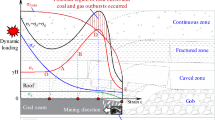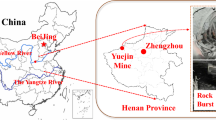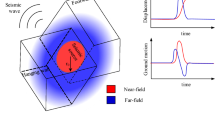Abstract
Mining-induced seismicity is one of the dynamic energy sources that can trigger coal burst. This paper presents a new methodology to assess coal burst risks under different loading conditions by examining seismic energy attenuation and fracture size. Two new indices are proposed: (1) Dynamic Load Index (DLI) quantifies the magnitude of dynamic loading induced by seismic events, based on the relationships between the seismic energy, peak particle velocity and dynamic stress; (2) dynamic–static loading assessment index, \(I_{\text{PD}}\), links the DLI with passive velocity tomography (PVT) to assess the coal burst risks in a longwall panel under dynamic and static loading. A total of 3080 seismic records were examined to validate \(I_{\text{PD}}\) in a typical burst-prone longwall panel in China. Based on the rate of occurrence of high-magnitude seismic events, \(I_{\text{PD}}\) thresholds were determined to identify low-, medium- and high-risk coal burst zones. Using this new zoning approach, coal burst risks were assessed in the same longwall panel while mining through a fault structure. The proposed risk classes correlated well with the recorded high-magnitude seismic events with energies over 10 kJ. The analysis indicated that 69% of the high-magnitude events occurred in the high-risk zones, where \(I_{\text{PD}}\) was between 0.35 and 1; and 31% of the events occurred in the medium-risk zones, where \(I_{\text{PD}}\) was between 0.2 and 0.35.
















Similar content being viewed by others
Abbreviations
- \(\rho\) :
-
Rock density
- v :
-
Particle vibration velocity
- G :
-
Shear modulus
- \(\lambda\) :
-
Elastic modulus
- E :
-
Seismic energy
- \(f\) :
-
Wave frequency
- m :
-
Particle mass
- \(r\) :
-
Hypocentral distance
- \(d\) :
-
Distance between seismic event and sensor
- A :
-
Wave amplitude
- c :
-
Wave velocity
- L :
-
Ray length of seismic wave
- \(r_{0}\) :
-
Fracture radius of seismic events
- \(E_{\text{P}}\), \(E_{\text{S}}\) :
-
P-wave and S-wave energy
- \(\Delta \sigma^{d}\) :
-
Dynamic stress
- \(\Delta \tau\) :
-
Shear stress drop
- \(\Delta \sigma\) :
-
Tensile stress drop
- \(W_{\text{s}}\), \(W_{\text{t}}\) :
-
Released strain energy by seismic event with shear and tensile fracture
- \(c_{\text{p}}\), \(c_{\text{s}}\) :
-
Wave velocity of P-wave and S-wave
- \(Q_{\text{p}}\), \(Q_{\text{s}}\) :
-
Quality factor for P-wave and S-wave
- \(d_{\text{s}}\), \(d_{\text{t}}\) :
-
Average displacement induced by shear slide and tensile fracture
- \(\sigma_{1}\), \(\sigma_{3}\) :
-
Maximum and minimum principal stress
- \(\sigma_{\text{v}}\) :
-
Vertical stress
- \(w_{1}\), \(w_{2}\) :
-
Weighting factors for the static loading and the dynamic loading in \(I_{\text{PD}}\)
- T :
-
Travel time
- \(S(x,y,z)\) :
-
Slowness
- \({\text{DSS}}\) :
-
Dynamic stress status
- \({\text{PVT}}\) :
-
Passive velocity tomography
- \(I_{\text{PD}}\) :
-
Dynamic–static loading assessment index
- \({\text{VA}}\) :
-
Velocity anomaly
References
Adams D, Hemp D, Spottiswoode S (1990) Ground motion in a backfilled stope during seismic events. In: ISRM international symposium, pp 13–22
Asef MR, Najibi AR (2013) The effect of confining pressure on elastic wave velocities and dynamic to static Young’s modulus ratio. Geophysics 78(3):D135–D142
Blake W, Hedley DG (2003) Rockbursts: case studies from North American hard-rock mines. Society for Mining, Metallurgy, and Exploration, Inc., Englewood
Boatwright J, Fletcher JB (1984) The partition of radiated energy between P and S waves. Bull Seismol Soc Am 74(2):361–376
Brady BH, Brown ET (2013) Rock mechanics: for underground mining. Springer Science & Business Media, New York
Bräuner G (2017) Rockbursts in coal mines and their prevention. Routledge, London
Butler A, Van Aswegen G (1993) Ground velocity relationships based on a large sample of underground measurements in two South African mining regions. In: Young RP (ed) Proceedings of the 3rd international symposium on rockbursts and seismicity in mines. A. A. Balkema, Rotterdam, pp 41–51
Cai M, Kaiser PK, Martin CD (1998) A tensile model for the interpretation of microseismic events near underground openings. In: Talebi S (ed) Seismicity caused by mines, fluid injections, reservoirs, and oil extraction. Springer, New York, pp 67–92
Cai W, Dou L, Si G, Cao A, He J, Liu S (2016) A principal component analysis/fuzzy comprehensive evaluation model for coal burst liability assessment. Int J Rock Mech Min Sci 81:62–69
Cai W, Dou L, Zhang M, Cao W, Shi J-Q, Feng L (2018) A fuzzy comprehensive evaluation methodology for rock burst forecasting using microseismic monitoring. Tunn Undergr Sp Technol 80:232–245
Cao A (2009) Research on seismic effort of burst and failure of coal rock mass associated with mining and its application. Ph.D. thesis, China University of Mining and Technology (in Chinese)
Cao A, Dou L, Cai W, Gong S, Liu S, Jing G (2015) Case study of seismic hazard assessment in underground coal mining using passive tomography. Int J Rock Mech Min Sci 78:1–9
Cao A, Dou L, Cai W, Gong S, Liu S, Zhao Y (2016a) Tomographic imaging of high seismic activities in underground island longwall face. Arab J Geosci 9(3):232
Cao A, Dou L, Wang C, Yao X, Dong J, Gu Y (2016b) Microseismic precursory characteristics of rock burst hazard in mining areas near a large residual coal pillar: a case study from Xuzhuang Coal Mine, Xuzhou, China. Rock Mech Rock Eng 49(11):4407–4422
Chen T, Wang X, Mukerji T (2015) In situ identification of high vertical stress areas in an underground coal mine panel using seismic refraction tomography. Int J Coal Geol 149:55–66
Daehnke M (2001) Review and application of stope support design criteria. J South Afr Inst Min Metall 101(3):135–164
Dou L, Chen T, Gong S, He H, Zhang S (2012) Rockburst hazard determination by using computed tomography technology in deep workface. Saf Sci 50(4):736–740
Dou L, He J, Cao A (2015) Rock burst prevention methods based on theory of dynamic and static combined load induced in coal mine. J China Coal Soc 40(7):1469–1476 (in Chinese)
Gibowicz SJ, Kijko A (1994) An introduction to mining seismology. Polish Academy of Sciences, Warsaw
Gibowicz S, Young R, Talebi S, Rawlence D (1991) Source parameters of seismic events at the Underground Research Laboratory in Manitoba, Canada: scaling relations for events with moment magnitude smaller than − 2. Bull Seismol Soc Am 81(4):1157–1182
Glazer S (2018) Mine seismology: seismic warning concept. Springer, New York
Hagan T, Milev A, Spottiswoode S, Vakalisa B, Reddy N (1998) Improvement of worker safety through the investigation of the site response to rockbursts. In: SIMRAC Final Project Report GAP 530, Department of Minerals and Energy, Pretoria, p 147
Hatherly PJ, Gale W, Medhurst TP, King A, Craig S, Poulsen B, Luo X (2003) 3D stress effects of longwall caving as revealed by microseismic monitoring. CSIRO Exploration and Mining, Canberra
He M, Qian Q (2010) The basis of deep rock mechanics. Science Press, Beijing (in Chinese)
Hildyard MW, Young RP (2002) Modelling seismic waves around underground openings in fractured rock. The mechanism of induced seismicity. Birkhäuser, Basel, pp 247–276
Hosseini N, Oraee K, Shahriar K, Goshtasbi K (2012) Passive seismic velocity tomography on longwall mining panel based on simultaneous iterative reconstructive technique (SIRT). J Cent South Univ 19(8):2297–2306
Kaiser PK (1996) Canadian rockburst support handbook: 1996. Geomechanics Research Centre, Vancouver
Kaiser PK, Cai M (2013) Keynote lecture: rockburst damage mechanisms and support design principles. In: Malovichko A, Malovichko D (eds) Proceedings of the 8th international symposium on rockbursts and seismicity in mines. Geophysical Survey of Russian Academy of Sciences, Moscow, pp 349–370
Kaiser PK, Maloney SM (1997) Ground motion parameters for design of support in burst-prone ground. In: Gibowicz SJ, Lasocki S (eds) Proceedings of the 4th international symposium on rockbursts and seismicity in mines. A. A. Balkema, Kraków, pp 337–342
Kozłowska M, Orlecka-Sikora B, Rudziński Ł, Cielesta S, Mutke G (2016) A typical evolution of seismicity patterns resulting from the coupled natural, human-induced and coseismic stresses in a longwall coal mining environment. Int J Rock Mech Min Sci 86:5–15
Lay T, Wallace TC (1995) Modern global seismology. Elsevier, Amsterdam
Lurka A (2008) Location of high seismic activity zones and seismic hazard assessment in Zabrze Bielszowice coal mine using passive tomography. China Univ Min Technol 18(2):177–181
Luxbacher K, Westman E, Swanson P, Karfakis M (2008) Three-dimensional time-lapse velocity tomography of an underground longwall panel. Int J Rock Mech Min Sci 45(4):478–485
Manouchehrian A, Cai M (2017) Analysis of rockburst in tunnels subjected to static and dynamic loads. J Rock Mech Geotech Eng 9(6):1031–1040
Mason I (1981) Algebraic reconstruction of a two-dimensional velocity inhomogeneity in the High Hazles seam of Thoresby colliery. Geophysics 46(3):298–308
McGarr A, Bicknell J, Sembera E, Green R (1989) Analysis of exceptionally large tremors in two gold mining districts of South Africa. In: Gibowicz SJ (ed) Seismicity in mines. Birkhäuser, Basel, pp 295–307
Meglis I, Greenfield R, Engelder T, Graham E (1996) Pressure dependence of velocity and attenuation and its relationship to crack closure in crystalline rocks. J Geophys Res Solid Earth 101(B8):17523–17533
Mendecki AJ (1996) Seismic monitoring in mines. Springer Science & Business Media, New York
Mendecki AJ (2016) Mine seismology reference book: seismic hazard. Institute of Mine Seismology, Huntingfield
Milev S (2005) Strong ground motion and site response in deep South African mines. J South Afr Inst Min Metall 105(7):515–524
Mutke G, Dubiński J, Lurka A (2015) New criteria to assess seismic and rock burst hazard in coal mines. Arch Min Sci 60(3):743–760
Orlecka-Sikora B (2010) The role of static stress transfer in mining induced seismic events occurrence, a case study of the Rudna mine in the Legnica–Glogow Copper District in Poland. Geophys J Int 182(2):1087–1095
Ortlepp W (2005) RaSiM comes of age—a review of the contribution to the understanding and control of mine rockbursts. In: Potvin Y, Hudyma M (eds) Proceedings of the 6th international symposium on rockburst and seismicity in mines. Australian Centre for Geomechanics, Western Australia, pp 3–20
Roberts M, Brummer R (1988) Support requirements in rockburst conditions. J South Afr Inst Min Metall 88(3):97–104
Spottiswoode S, Churcher J (1988) The effect of backfill on the transmission of seismic energy. Backfill in South African mines. South African Institute of Mining and Metallurgy, Johannesburg, pp 203–217
Stec K (2007) Characteristics of seismic activity of the Upper Silesian Coal Basin in Poland. Geophys J Int 168(2):757–768
Stiros SC, Kontogianni VA (2009) Coulomb stress changes: from earthquakes to underground excavation failures. Int J Rock Mech Min Sci 46(1):182–187
Vardar O, Tahmasebinia F, Zhang C, Canbulat I, Saydam S (2017) A review of uncontrolled pillar failures. Proced Eng 191:631–637
Vardar O, Zhang C, Canbulat I, Hebblewhite B (2018) A semi-quantitative coal burst risk classification system. Int J Min Sci Technol 28:721–727
Wagner H (1984) Support requirements for rockburst conditions. Can J Earth Sci 21:P1410–P1414
Wang X (2015) Numerical modeling of seismic wave propagation in underground mines. Ph.D. thesis, Laurentian University of Sudbury
Wepfer W, Christensen N (1991) A seismic velocity-confining pressure relation, with applications. Int J Rock Mech Min Sci Geomech Abstr 28(5):451–456
Zhang C, Canbulat I, Hebblewhite B, Ward CR (2017) Assessing coal burst phenomena in mining and insights into directions for future research. Int J Coal Geol 179:28–44
Acknowledgements
The work is supported by the Fundamental Research Funds for the Central Universities (2017XKQY046) and the Project of PAPD funded by the Priority Academic Programme Development of Jiangsu Higher Education Instruction (SZBF2011-6-B35).
Author information
Authors and Affiliations
Corresponding author
Additional information
Publisher's Note
Springer Nature remains neutral with regard to jurisdictional claims in published maps and institutional affiliations.
Rights and permissions
About this article
Cite this article
Wang, C., Cao, A., Zhang, C. et al. A New Method to Assess Coal Burst Risks Using Dynamic and Static Loading Analysis. Rock Mech Rock Eng 53, 1113–1128 (2020). https://doi.org/10.1007/s00603-019-01968-5
Received:
Accepted:
Published:
Issue Date:
DOI: https://doi.org/10.1007/s00603-019-01968-5




